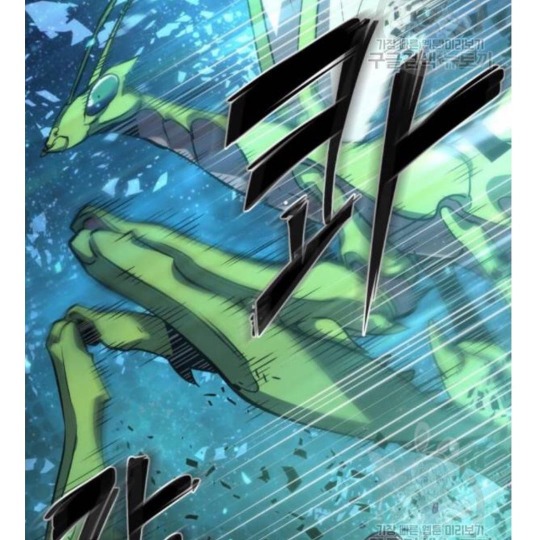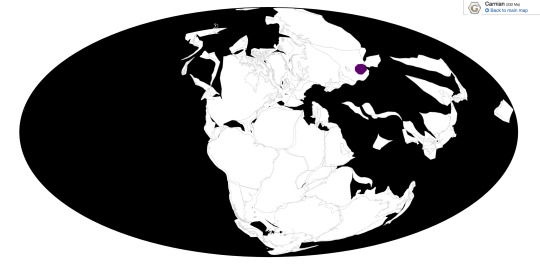#titanoptera
Text
The sun rises over Dimetrodon as it travels across the landscape of the Middle Permian, spotting Diplocaulus, Titanoptera, a speculative proto-archosauromorph, and Prionosuchus along the way.
The piece 'Morning, when time had no end' was very kindly composed for this animation by the immensely talented Villi-refurinn. Check them out on Bandcamp for more fantastic music!
This one took a lot longer than usual, with life getting in the way and all that. Thank you all sincerely for waiting for so long!
4K notes
·
View notes
Text

Titanopteran! They’re an extinct order of grasshopper relatives with raptorial claws. I just learned these things existed yesterday but I just had to draw one.
36 notes
·
View notes
Text
Clatrotitan – Aussie Predatory Bug

Clatrotitan is an extinct genus of titanopteran insect, known from the Triassic of Australia. It is originally described from a species, Clatrotitan andersoni.
Known as King Israel's Mantidbug by the Conservationist Hunters of Indigenous Australians, but isn't real mantidfly, but a titanopteran in Triassic period enter either Late Cretaceous or Holocene epoch, the present day.
Physiology
Clatrotitan andersoni had a large forewing, which was 13.8 centimetres (5.4 in) long, with spiny points on elbows in three pairs of legs, long antennas, and ten segmented abdomen. Their wings have brownish black vertical lines on four wings, one was larger and one was small.
This drawing was made by Ognimdo2002
#ognimdo2002#earth responsibly#earth#art#earthresponsibly#ibispaint art#paleoart#paleoillustration#Paleoctober#bug#clatrotitan andersoni#clatrotitan#titanoptera#titanopteran#rapunzles tangled adventure#ancient#prehistoric
3 notes
·
View notes
Text
WN Non-Sapient Animal Lower Bracket


["Anti-Propaganda" is NOT allowed. Please be courteous and only give reasons to vote FOR a character.]
Kotex Paw Pad kitten from the SVSSS donghua pad commercial
Type of Animal: cat
Tumblr Image Link
Titano from ORV
The 6th-grade insect king Titanoptera that Lee Gilyoung befriended in the Theatre Dungeon. A good insect!!!!
#kotex paw pad kitten#svsss#mxtx#titano#omniscient reader's viewpoint#orv#polls#nonsapient lower round 2#nonsapient wn animal bracket#nonsapient lower bracket#webnovel animal tournament#queue
22 notes
·
View notes
Text
I think mantisization is more common than carcinization, actually. Nothing on land or in freshwater that really spontaneously evolved into a crab, but lots of things on land (mantidflies, ambush bugs, thread-legged bugs, Ochthera flies, the extinct Titanoptera, even baviine jumping spiders), in freshwater (water bugs, especially water scorpions... even *on* freshwater, counting water striders) and in the ocean (mantis shrimp, skeleton shrimp) that keep evolving into mantises! Even among mammals, silky anteaters have mantis-like claws (though it doesn't use them the same way, but they do have similar sluggishness, and similar threat poses)!
79 notes
·
View notes
Text
Gigatitan

By Ripley Cook
Etymology: Large titan
First Described By: Sharov, 1968
Classification: Biota, Archaea, Proteoarchaeota, Asgardarchaeota, Eukaryota, Neokaryota, Scotokaryota Opimoda, Podiata, Amorphea, Obazoa, Opisthokonta, Holozoa, Filozoa, Choanozoa, Animalia, Eumetazoa, Parahoxozoa, Bilateria, Nephrozoa, Protostomia, Arthropoda, Mandibulata, Pancrustacea, Hexapoda, Insecta, Dicondylia, Pterygota, Metapterygota, Neoptera, Polyneoptera, Anartioptera, Polyorthoptera, Orthopterida, Panorthoptera, Titanoptera, Gigatitanidae
Referred Species: G. extensus, G. magnificus, G. vulgaris
Status: Extinct
Time and Place: 242 to 227 million years ago, from the Ladinian of the Middle Triassic to the Carnian of the Late Triassic.

Gigatitan is known from Kyrgyzstan.

Physical Description: Gigatitan was a very large insect, with a wingspan of 33 centimeters (13 inches). It’s one of the better-known members of Titanoptera, an extinct clade of large predatory insects. It would have looked a little like a giant mayfly, but with a katydid-lke head and much lnger antennae. The forelegs were large and bore sharp spines, similar to those of praying mantises. The wings were large and had distinct fluting. The ovipositor of Gigatitan has sharp ridges, similar to the earlier Carboniferous insect Gerarus.
Diet: Gigatitan was a predator, and its diet potentially included other insects and even small reptiles.
Behavior: It is likely titanopterans had similar lifestyles to modern praying mantises, living as arboreal predators. Their large wings would have allowed them to fly, but their relatively small hindlimbs wouldn’t have allowed them to leap very far. The fluting on the wings could be rubbed by the hindlimbs to produce sound, similar to the chirping of crickets, but if I had to wager, it’d be even more abrasive to the ear. The cutting ridges on the ovipositor were likely used to cut holes in plant material, so that it could lay eggs inside.
Ecosystem: Gigatitan’s fossils were found in the Madygen Formation, which is probably more famous for harboring the bizarre reptiles Longisquama and Sharovipteryx. The Madygen Formation environment was a forested submontane region, with rivers leading out to a large lake. The lowland forests were composed of lycophytes, seed ferns, cycads, gingkos, conifers, and horsetails, with many aquatic plants by the swampy coast. Titanopterans such as Gigatitan preferred the upland regions, which were also home to the cynodont Madysaurus. The environment was flourishing with insects; other insects known include other species of titanopteran, mayflies, cockroaches, hymenopterans, flies, beetles, notopterans, caddisflies, orthopterans, cicadas, and true bugs. The rivers and lakes harbored the amphibian Triassaurus, mollusks, worms, crustaceans, and many fish such as Oshia, Saurichthys, the lungfish Asiatoceratodus, and hybodont and xenacanthid sharks.
Other: Gigatitan is one of the largest insects to have evolved beyond the Carboniferous.
~ By Henry Thomas
Sources under the Cut
Bethoux, O., Galtier, J., Nel, A. (2004). “Earliest Evidence of Insect Endophytic Oviposition”. Palaios 19: 408-413.
Carlton, R.L. (2018). A Concise Dictionary of Paleontology. Springer International Publishing.
Grimaldi, D. (2009). “Fossil Record”. IN: Resh, V.H., Carde, R.T. eds. Encyclopida of Insects. Cambridge Academic Press.
Voigt, S., Spindler, F., FIscher, J., Kogan, I., Buchwitz, M. (2007) “An extraordinary lake basin - the Madygen fossil lagerstaette (Middle to Upper Triassic, Kyrgyzstan, Central Asia)”. Palaontologische Gesellschaft 2007, Freiberg.
#Gigatitan#Insect#Arthropod#Triassic#Palaeoblr#Prehistoric Life#Paleontology#Prehistory#Gigatitan extensus#Gigatitan magnificus#Gigatitan vulgaris#Triassic Madness#Triassic March Madness
375 notes
·
View notes
Text
WN Non-Sapient Animal Upper Bracket


["Anti-Propaganda" is NOT allowed. Please be courteous and only give reasons to vote FOR a character.]
Fairy from MDZS
Type of Animal: dog
Wiki Link
Titano from ORV
The 6th-grade insect king Titanoptera that Lee Gilyoung befriended in the Theatre Dungeon. A good insect!!!!
#fairy#mdzs#mxtx#titano#orv#polls#nonsapient upper round 1#nonsapient wn animal bracket#nonsapient upper bracket#webnovel animal tournament#queue
10 notes
·
View notes
Text
WN Non-Sapient Animal Lower Bracket


["Anti-Propaganda" is NOT allowed. Please be courteous and only give reasons to vote FOR a character.]
Titano from ORV
The 6th-grade insect king Titanoptera that Lee Gilyoung befriended in the Theatre Dungeon. A good insect!!!!
Xiao Lu from Of Mountains and Rivers / Shan He Biao Li
Type of Animal: Snake
Submission: The cutest little snake who follows the MC home. (MC: you are not a cute puppy! *pets it* *is a snake dad now*) Saves MC's life. Grows a little bigger over the course of the novel. Plays a major role in the finale but that's mega spoilers.
#titano#orv#xiao lu#of mountains and rivers#shan he biao li#polls#nonsapient lower round 1#nonsapient wn animal bracket#nonsapient lower bracket#webnovel animal tournament#queue
7 notes
·
View notes